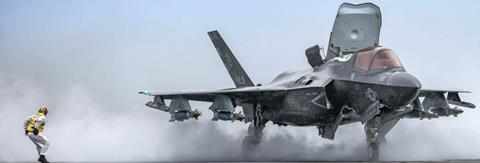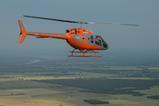Test pilots recently pushed the operational limits of Lockheed Martin F-35Bs during trials from a UK Royal Navy (RN) aircraft carrier that included alternative landing techniques and operating with heavy loads.
Aviators with the US Marine Corps (USMC) flew the short take-off and vertical landing variant of the fifth-generation fighter from HMS Prince of Wales, completing a rolling vertical landing – a first aboard the ship – and ski-jump-assisted launch of an F-35B carrying an ultra-heavy payload.

The US Department of Defense (DoD) says the milestone rolling vertical landing occurred on 19 October while Prince of Wales sailed off the USA’s eastern seaboard for naval exercises in the Western Atlantic.
The evaluations are part of developmental testing for the F-35, a process the Pentagon performs throughout the acquisition process to “assist in engineering design and development and to verify that technical performance specifications have been met”.
The rolling landing trials were meant to evaluate the ability of F-35Bs to return to ships while carrying heavier-than-typical payloads. “The landing technique could lead to tactics where a pilot returns to the ship with heavier loads, for example [with] more fuel or weapons,” the Pentagon says.
Standard vertical landings involve pilots approaching to the port side of carriers in vertical flight mode, then flying sideways over the deck, hovering over the landing spot and touching down. The rolling landings involved F-35Bs descending in vertical flight mode from aft of the carrier while maintaining some forward momentum. The pilots completed short low-speed rolls after touching down to bleed momentum before braking.
While Prince of Wales is the Royal Navy’s largest warship, the short-runway carrier is not equipped with the catapult-assisted take-off and arresting-wire-recovery systems of the US Navy’s Nimitz and Ford-class super-carriers.
The RN operates the vertical-capable F-35B from its aircraft carriers Queen Elizabeth and Prince of Wales, which are equipped with ski-jump ramps. It previously flew the BAE Systems Harrier GR9/9A from smaller, Invincible-class ships.
“During this phase of our deployment we will see the jet develop advanced landing and take-off techniques, allowing it to recover heavier, turn around faster and launch with more weapons,” says Captain Richard Hewitt, commanding officer aboard Prince of Wales.
Separately, crews tested the ability of an F-35B to launch from the carrier with an ultra-heavy load of weapons. The RN revealed the manoeuvres on 20 October.
The F-35’s standard weapons load is 6,800kg (15,000lb), according to Lockheed’s website. However, under a configuration the RN colloquially calls “beast mode”, maxed-out F-35Bs can carry 9,980kg of payload – roughly three times more than the UK’s final Harrier GR9 variant, the service says.

Reaching that payload involves fully loading the fighter’s stealthy internal weapons bays and hanging additional munitions from optional underwing pylons.
To accomplish the heavy take-off, test pilots executed a so-called “run-up” launch, starting from the aft end of the flight deck and rocketing toward the ship’s ski jump ramp. It was the first run-up launch conducted from either Prince of Wales or its sister ship Queen Elizabeth.
The RN says pilots flew the trials using a specially modified F-35B from the US Navy’s Integrated Test Force. The fighter was loaded with a combination of inert 226kg (500lb) Raytheon Paveway IV laser-guided bombs and inert 453kg Paveways in the weapons bay.
“I took great pleasure in continuing to expand the war fighting capacity of Britain’s biggest warship,” says USMC Lieutenant Colonel Mike Lippert, a test pilot who flew both a run-up launch and rolling vertical landing.
“There has been undeniable growth and progress,” he adds of the RN’s F-35B carrier operating capability.































